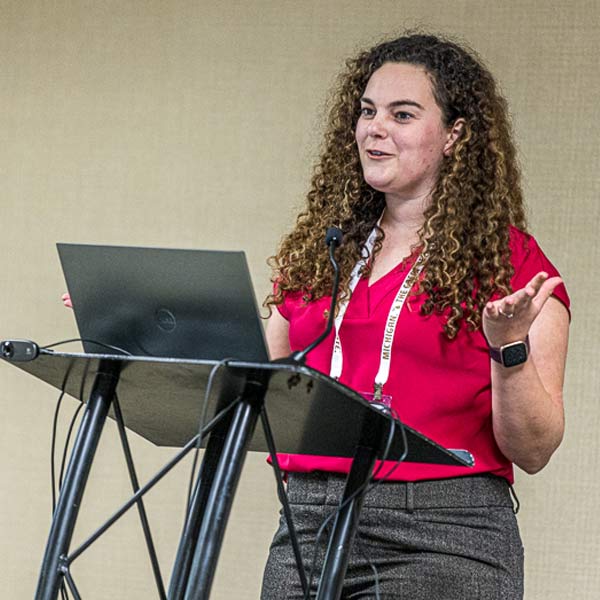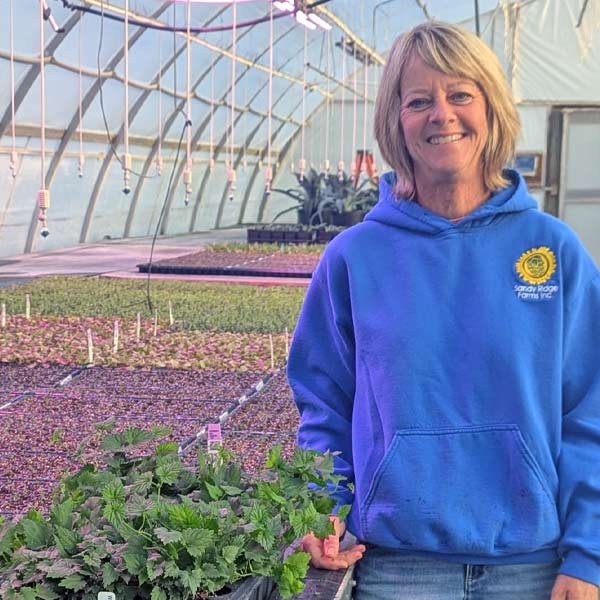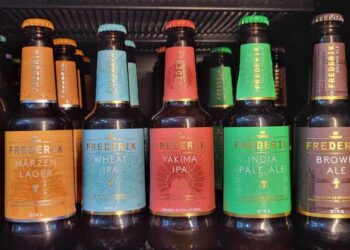“Wait! Women run hop farms in Michigan?”
That was the response from one brewer as I gathered information for this story. While Michigan ranks number one in the Great Lakes region and number four nationally for total hop acreage, many of the women driving that success remain behind the scenes. From harvest coordination and greenhouse propagation to research and land stewardship, they’re doing the work, just not always getting the credit.
So, why Michigan?
Hops are a little high maintenance. They like long, sunny days, but not too hot. They insist on cold winter nights so they can enter dormancy. The sweet spot for those conditions is the 45th parallel, which cuts right through Michigan. And while hops love a good drink, they hate wet feet, so well-drained soil is a must. Thankfully, those glaciers that rolled through ages ago left Michigan with just the right dirt for the job.
Grapes grow on vines, but hops grow on bines. Unlike vines, which use tendrils to climb, bines rely on stiff hairs along their stems to wrap clockwise around twine and rise up, often more than 20 feet in a single season.
“They’re strong but delicate,” says Mel Trowbridge of Top Hops Farm in Goodrich, Mich. “You’ve got to handle them with care when they’re young, but later, during harvest, it’s like wrestling a jungle.”
Despite ideal growing conditions, small and independent growers in Michigan face a range of challenges, including climate change, market contraction, labor shortages—and an ongoing lack of visibility for women in the industry.
Guiding the Growth: Erin Lizotte, MSU

Ask anyone involved with Michigan hops, and they’ll tell you that without Michigan State University (MSU), the industry wouldn’t be thriving. And when it comes to pest management, climate shifts, or crop concerns, Erin Lizotte’s name rises to the top.
As MSU’s integrated pest management coordinator and senior statewide educator, Lizotte is one of several experts whom growers across the state can consult for a variety of issues. From diagnosing disease to navigating chemical approvals, the extension team offers timely, research-backed support that hop farmers trust. Their close collaboration with MSU’s Plant and Pest Diagnostics lab helps ensure growers have access to critical testing.
“She’s incredibly knowledgeable and responsive,” one grower said. “I wouldn’t feel confident making some of these decisions without her input.”
Propagating the Future: Julie Kane, Sandy Ridge Farms

Michigan’s hop resurgence also depends on skilled propagators such as Julie Kane. With more than 20 years of experience in the greenhouse industry, Kane had been growing flowering annuals and perennials alongside the Vanden Heuvel family at Sandy Ridge Farms in Zeeland, Mich. Then, around 2008, interest in hops reignited across the state.
“Our greenhouse was the first propagator and grower in Michigan,” Kane says. “As requests for hop plants grew, it became clear someone needed to take the reins…and that someone was me.”
Hops quickly became her specialty. Kane leaned into research and observation to determine how to grow the healthiest plants possible. Soon, she earned a reputation for quality starter stock. But as one of the few women in a male-dominated field, her expertise wasn’t always recognized early on.
“In the beginning, group conversations were sometimes directed around me,” she recalls. “But as our reputation for quality grew, the barriers started to fall away.”
Kane follows a Clean Plant protocol: Starting with a virus-free mother plant from the Clean Plant Network, she ensures strict sanitation of tools, applies preventative fungicide sprays, and schedules yearly testing with MSU to keep their stock clean.
Climate change has made this work even more crucial. Kane points to this past summer’s prolonged heat wave as a clear stressor on her crop.
“It was unusually hot and humid all season,” she says. “Inside the greenhouses, it was easily over 100 degrees. We added extra shade cloth and increased watering and fungicide applications just to keep the plants alive.”
Kane praises MSU researchers for their work getting growers the tools to fight disease. She also sees more women stepping into both growing and brewing roles and describes the greenhouse side of the industry as “very accepting.”
“Being just a small part of bringing the hop industry back to Michigan will be remembered as one of my most fulfilling accomplishments,” she says. “I have growers that stop by just to say hi and give updates. I love the hop plant—it smells amazing. And there’s nothing better after a hot day in the greenhouse than a cold craft beer made with Michigan hops.”
Rooted in Stewardship: Bonnie Steinman & Elizabeth Mullins, Bell’s Brewery

Bonnie Steinman’s hop journey started with a backyard experiment. A longtime horticulturist and pest management pro, she planted a few rhizomes and was hooked. Since then, she’s co-founded Hop Head Farms, worked with MSU researchers, and now serves as land steward at Bell’s Brewery in Comstock. There, she oversees hop yard operations and mentors colleague Elizabeth Mullins, who helps lead harvest and field operations.
Steinman’s role evolved out of a long-standing working relationship with John Mallett, former vice president of operations at Bell’s. “John knew I could grow quality hops. That’s really how it started,” she says. “And he understood the value of investing in local agriculture.”
One early learning experience came under Mallett’s guidance. Instead of rushing the harvest, he told Steinman to trust her senses. “Smell them every day,” he said. “Tell me what you notice.” At first, the Chinook smelled grassy, then fruity, then sticky with resinous oils. That daily practice of rubbing and smelling cones stuck with her and now it’s part of how she teaches others.
Mullins, who has a background in pest management, scouts the yard with Steinman to monitor for threats. “We grow five varieties, and now I can ID them just by looking at the cones,” she says. Together, Steinman and Mullins manage the brewery’s two-and-a-half-acre hop yard and broader sustainability efforts, including an apple orchard, employee garden, butterfly waystation, and a special area of the yard known as The Hideaway. Inspired by Steinman’s visit to TopWire Hop Project in Oregon, The Hideaway is a lush, green gathering space beneath the towering bines.
“It’s like being underwater in a kelp forest,” Steinman says. “I wanted people to see hops the way we do—surrounded by them at their peak.”
For Steinman, a successful harvest isn’t just about logistics; it’s emotional. “I’ve been staring at these plants since April,” she says. “We go through a lot together.” And the real reward is knowing that brewers will make great beer with them. “To sit down and enjoy those beers—that feels like success.”
That passion extends to the community. Steinman and Mullins welcomed members of the Pink Boots Society, a group supporting women and nonbinary professionals in the beverage industry, to step into the Hideaway, right when the hops were most alive.
Built for Quality: Mel Trowbridge, Top Hops Farm

With more than 40 years of experience as an automotive engineer and quality control specialist, Trowbridge brought structure and intention to the farm. She built a process-driven operation where everyone is trained, tasks rotate, and every workday ends with a team debrief, just as it did back on the plant floor. “At the end of every shift, we all gather. Some have a beer, some don’t, and we talk about what went well, what didn’t, what could be better,” she said.
At harvest time, her role is orchestration: keeping everyone on time, adjusting the schedule as needed, and ensuring each crew member knows what comes next. She doesn’t shy away from making decisions, and she certainly doesn’t need a whip to run a tight ship.
Celebrating Chinook: Rose Stahl, Mr. Wizard’s Hops

“Chinook is Michigan’s variety,” says Steinman. “It has its own identity—pineapple, fruit, less resin than the Pacific Northwest.” She believes it deserves far more attention from brewers nationwide. Since 2017, Michigan’s signature hop has taken center stage at the Great Beer State Conference and Trade Show, where the Chinook Cup honors the best of the harvest.
The contest, hosted by Hop Growers of Michigan, gives growers a chance to showcase their finest Chinook and take home serious bragging rights. For years, Rose Stahl, co-owner of Mr. Wizard’s Hops in Monroe, has helped organize the event, just one of many ways she has helped move the industry forward.
Stahl’s journey into hop farming started not with a business plan, but with a ruined cornfield and a casual suggestion from her son. After 30 solid days of rain, which turned part of their southeast Michigan farm into a lake—so deep that eagles were bathing in it—Rose and her husband, John, were at a loss.
“We lost over five acres of corn,” she recalled. Her son, who had just started working at Short’s Brewing near Traverse City, looked at their sandy soil and said, “Why don’t you try growing hops?” Rose turned to him and asked, “What are hops?”
That summer, they planted a test row, harvested enough to brew a small batch of beer, and threw a party in their greenhouse to share it. Encouraged by the results, they planted two acres the following year.
Ten years later, Stahl is still in the field, though she admits they’re starting to scale back. “We’re getting older,” she says with a laugh, “but it’s been one heck of a ride.”
Carving Out an Identity
Hop farming may appear to be a male-dominated industry, but many Michigan farms thrive thanks to women doing essential behind-the-scenes labor. On family farms, men are often the public face, “but women make substantial contributions that often go unseen,” insists Amy Tennis of Michigan Hop Alliance.
She spent nearly a decade working full-time off the farm while spending evenings in the yard—mowing, weeding, training bines, managing irrigation, applying for grants, organizing fundraisers, and handling the books. Farming, she says, is humbling. You learn something one year, and it’s another year before you can apply it. It’s a long game, and Michigan’s hop story is still being written, but the women behind the bines are shaping what comes next.
“We’re not the Pacific Northwest,” says Nicole Shriner, hops researcher at MSU. “But we can carve out our own identity. We want people to say, ‘Oh, this has Michigan hops in it,’ and know that means something special.”
Brenda Marshall is a Michigan-based writer and co-founder of Life In Michigan, where she covers beer culture and shares behind-the-scenes looks at the places and people shaping the state today. She also serves on the board of GIG: The Art of Michigan Music Foundation, a nonprofit celebrating visual artists in the Michigan music industry. Offline, you’ll find her exploring Michigan backroads, experimenting with fiber arts, or spotting the next bird for her life list.
CraftBeer.com is fully dedicated to small and independent U.S. breweries. We are published by the Brewers Association, the not-for-profit trade group dedicated to promoting and protecting America’s small and independent craft brewers. Stories and opinions shared on CraftBeer.com do not imply endorsement by or positions taken by the Brewers Association or its members.






